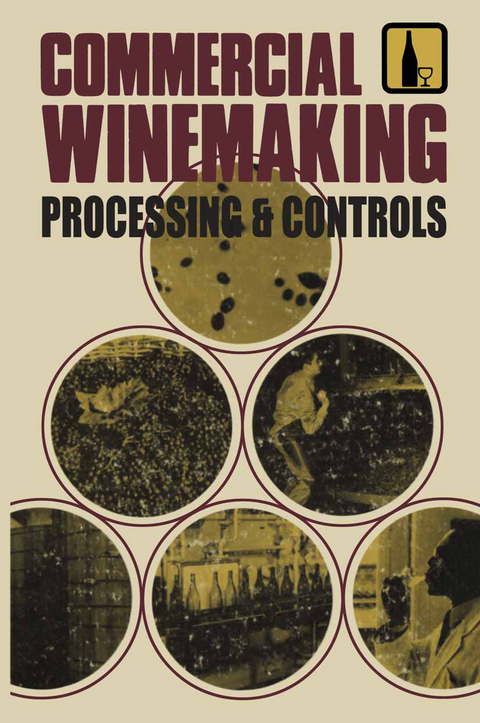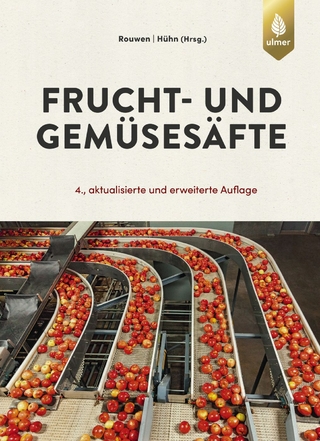
Commercial Winemaking
Processing and Controls
Seiten
2012
|
Softcover reprint of the original 1st ed. 1981
Springer (Verlag)
978-94-015-1151-3 (ISBN)
Springer (Verlag)
978-94-015-1151-3 (ISBN)
The very first winemaster may have been a cave man who discovered the magic of fermentation by tasting the result of some crushed grapes having been left inadvertently for a few days. The term table wine suggests the use for which these wines are intended-at the table with food.
The very first winemaster may have been a cave man who discovered the magic of fermentation by tasting the result of some crushed grapes having been left inadvertently for a few days. Wine will, literally, make itself. In simplest terms, yeast cells will collect on the outside of grape skins in the form of bloom and, when exposed to the natural sweetness inside the fruit, fermentation of the sugar into carbon dioxide gas and ethyl alcohol will commence. During the millenia that have transpired since the cave man, the state of the art has evolved into five generally accepted categories of classification. Table wines are usually dry (made with no appreciable amount of fer mentable sugar remaining) or nearly so, and contain less than 14% alcohol by volume. They can be white, pink or red and are the result of uncompli cated processes of fermentation, clarification, stabilization, aging and bot tling. The term table wine suggests the use for which these wines are intended-at the table with food. The overwhelming majority of the wine produced in the world is in this category. Table wines range from the obscure and ordinary to the most expensive classics known to man.
The very first winemaster may have been a cave man who discovered the magic of fermentation by tasting the result of some crushed grapes having been left inadvertently for a few days. Wine will, literally, make itself. In simplest terms, yeast cells will collect on the outside of grape skins in the form of bloom and, when exposed to the natural sweetness inside the fruit, fermentation of the sugar into carbon dioxide gas and ethyl alcohol will commence. During the millenia that have transpired since the cave man, the state of the art has evolved into five generally accepted categories of classification. Table wines are usually dry (made with no appreciable amount of fer mentable sugar remaining) or nearly so, and contain less than 14% alcohol by volume. They can be white, pink or red and are the result of uncompli cated processes of fermentation, clarification, stabilization, aging and bot tling. The term table wine suggests the use for which these wines are intended-at the table with food. The overwhelming majority of the wine produced in the world is in this category. Table wines range from the obscure and ordinary to the most expensive classics known to man.
1 Wine and the History of Western Civilization.- 2 The Winery and the Laboratory.- 3 Grapes, Juice and Must Quality Control.- 4 Quality Control During Primary Fermentation.- 5 Quality Control During Aging, Clarification and Stabilization.- 6 Quality Control During Bottling and Warehousing.- 7 Dessert and Aperitif Wine Quality Control.- 8 Sparkling Wine Quality Control.- 9 Microbiological Analysis in the Small Winery Laboratory.- 10 ATF and Supplemental Recordkeeping.- Appendix A: Analytical Methods and Procedures in the Small Winery Laboratory.- Appendix B: Charts and Tables.- Appendix C: Conversion Tables.
| Zusatzinfo | 138 Illustrations, black and white; XII, 500 p. 138 illus. |
|---|---|
| Verlagsort | Dordrecht |
| Sprache | englisch |
| Maße | 152 x 229 mm |
| Themenwelt | Schulbuch / Wörterbuch |
| Geisteswissenschaften | |
| Naturwissenschaften | |
| Sozialwissenschaften | |
| Technik ► Lebensmitteltechnologie | |
| Weitere Fachgebiete ► Land- / Forstwirtschaft / Fischerei | |
| ISBN-10 | 94-015-1151-9 / 9401511519 |
| ISBN-13 | 978-94-015-1151-3 / 9789401511513 |
| Zustand | Neuware |
| Haben Sie eine Frage zum Produkt? |
Mehr entdecken
aus dem Bereich
aus dem Bereich
Technologie, Chemie, Mikrobiologie, Analytik, Bedeutung, Recht
Buch | Hardcover (2023)
Verlag Eugen Ulmer
140,00 €


